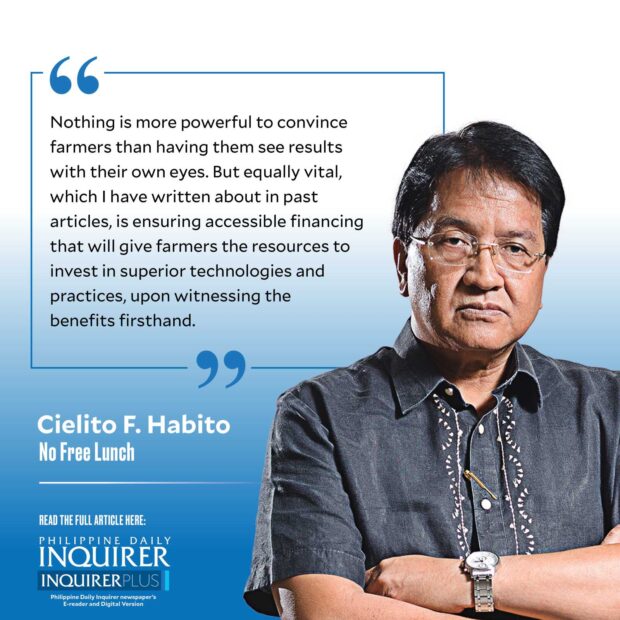To see is to believe

Small farmers, especially those who have tilled the soil as their livelihood for many years, can be a challenging lot to pitch new technologies and practices to. Since my days as an agriculture student over half a century ago at the University of the Philippines Los Baños (then still just the UP College of Agriculture), farmers had been described—many believe wrongly—as being resistant to change and unwilling to try new things.
Arthur Mosher’s book “Getting Agriculture Moving,” which was in every agricultural economist’s library then, spoke of farmers’ adaptability to changing technologies as critical for successful rural and agricultural development. But then and now, getting them to adopt more efficient and productive farm practices has been a formidable hurdle. And it is lagging farm productivity that lies at the root of our unduly high food prices and resulting high child malnutrition levels—which in turn makes our already bad education crisis even worse with impaired cognitive and learning abilities of our children in school.
Over the past year, I traveled around the country to observe things on the ground and see firsthand the key challenges we face in enabling our farmers and fishers to improve their productivity and reduce production costs. I led a Brain Trust Inc. team in an assessment of the country’s agriculture and fishery extension landscape for the Agricultural Training Institute (ATI) of the Department of Agriculture, a function long devolved to local governments by the 1991 Local Government Code.
On the part of farmers and fishers who are the ultimate targets of farm and fishery extension work, the attitude captured in the Ilocano phrase jak pati jak kita (to see is to believe) exemplifies a basic barrier to making them more productive. It arose prominently in consultations not only in Northern Luzon but in the rest of the country. This suggests that the delivery of extension services is best done in a way that allows farmers to witness firsthand, ideally on their own farms, the benefits of adopting improved technologies and farm practices.
This is where the work of 2012 Ramon Magsaysay awardee Dr. Romulo Davide has made an important contribution since the early 1990s. Driven by the conviction that “there is no barren soil, only barren minds,” he championed the application of science by small farmers themselves and showed that small farmers can be scientists, too. To him, a scientist is one who “watches things, reads, finds out how things work and how they can be made better, wonders, experiments, finds out what is true, and sees that wonderful things do indeed happen.”
Believing that any farmer can be all of these, he developed a holistic program wherein farmers, guided by scientists, design and conduct experiments on land preparation, alternative plant varieties and fertilizers, intercropping, and others. Upon seeing what works, farmers apply the science-based methods and technologies learned in their own farms. Trained farmers are later asked to teach fellow farmers in their barangay as volunteer technicians and extension workers. This rounds up an integrated research for development and extension system, now known as R4DE (improving on the traditional notion of R&D), wherein farmers themselves can be both beneficiaries and change agents.
Davide’s Farmer-Scientist Training Program or FSTP is now a valuable part of ATI’s toolkit as it helps local governments make good on their task of capacitating and empowering Filipino farmers and fishers. All over the country, ATI accredits learning sites for agriculture or LSAs, which are demonstration farms where farmer-trainees can see with their own eyes the results of using alternative methods, plant varieties, and fertilizers.
We visited LSAs that had demonstration plots for the “minus-one element technique” or MOET developed by the Philippine Rice Research Institute, which helps detect a lack of nitrogen, phosphorus, potassium, sulfur, zinc, or copper in farmers’ soils. Here, one clearly sees the effect on the rice plant when one specific element is missing from the soil. Some LSAs allow farmers to witness the result of the alternate wetting and drying or AWD technique in rice production that saves large amounts of irrigation water while reducing greenhouse gas emissions (versus the common practice of continuous flooding of the rice field).
Nothing is more powerful to convince farmers than having them see results with their own eyes. But equally vital, which I have written about in past articles, is ensuring accessible financing that will give farmers the resources to invest in superior technologies and practices, upon witnessing the benefits firsthand.
No, farmers are not inherently resistant to change. They just need to see to believe—or as our northern brothers declare, jak pati jak kita.
cielito.habito@gmail.com




















